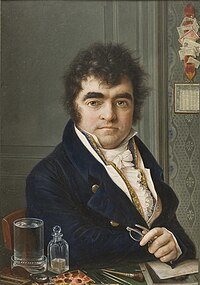Portal:The arts
T H E A R T S P O R T A L
The arts or creative arts are a wide range of human practices of creative expression, storytelling, and cultural participation. They encompass multiple diverse and plural modes of thinking, doing, and being, in an extremely broad range of media. Both dynamic and a characteristically constant feature of human life, they have developed into innovative, stylized, and sometimes intricate forms. This is often achieved through sustained and deliberate study, training, and/or theorizing within a particular tradition, across generations, and even between civilizations. The arts are a vehicle through which human beings cultivate distinct social, cultural, and individual identities while transmitting values, impressions, judgements, ideas, visions, spiritual meanings, patterns of life, and experiences across time and space.
Prominent examples of the arts include:
- visual arts (including architecture, ceramics, drawing, filmmaking, painting, photography, and sculpting)
- literary arts (including fiction, drama, poetry, and prose)
- performing arts (including dance, music, and theatre)
They can employ skill and imagination to produce objects and performances, convey insights and experiences, and construct new environments and spaces.
The arts can refer to common, popular, or everyday practices as well as more sophisticated, systematic, or institutionalized ones. They can be discrete and self-contained or combine and interweave with other art forms, such as the combination of artwork with the written word in comics. They can also develop or contribute to some particular aspect of a more complex art form, as in cinematography. By definition, the arts themselves are open to being continually redefined. The practice of modern art, for example, is a testament to the shifting boundaries, improvisation and experimentation, reflexive nature, and self-criticism or questioning that art and its conditions of production, reception, and possibility can undergo.
As both a means of developing capacities of attention and sensitivity and as ends in themselves, the arts can simultaneously be a form of response to the world and a way that our responses and what we deem worthwhile goals or pursuits are transformed. From prehistoric cave paintings to ancient and contemporary forms of ritual to modern-day films, art has served to register, embody, and preserve our ever-shifting relationships to each other and to the world. (Full article...)
Featured articles -
Featured picture
 Credit: Louis-Marie Autissier
Credit: Louis-Marie AutissierA self-portrait of Louis-Marie Autissier (1772–1830), a French-born Belgian portrait miniature painter. He is considered the founder of the Belgian school of miniature painting in the nineteenth century. Born at Vannes, in Brittany, he joined the French Revolutionary Army at Rennes in 1791. On leaving the army in 1795, Autissier went to Paris and trained his art by studying paintings at the Louvre. In 1796 he settled in Brussels, but continued to divide his time between Belgium, the Netherlands, and France. Although he enjoyed great success in his career, serving as court painter to Louis Napoleon, French King of the Netherlands, and later to Willem I, Autissier died penniless.
Did you know...
- ... that the Analatos Painter, Mesogeia Painter and Polyphemos Painter (work pictured) were early Greek vase painters of the Proto-Attic period, active between 700 and 650 BC?
- ... that Steven Spielberg originally cast Tony Award nominee Julyana Soelistyo as Pumpkin in the film Memoirs of a Geisha?
- ... that Roujin Z is a 1991 Japanese anime film about a computerized hospital bed with its own built-in atomic power reactor?
In this month
- 5 May 1726 – Handel's opera Alessandro premieres at the King's Theatre in London with Italian castrato singer Senesino in the title role
- 12 May 1926 – Dmitri Shostakovich's Symphony No. 1, which he composed at the age of 19 while a student at Leningrad Conservatory, receives its first performance
- 22 May 1844 – Impressionst painter and printmaker Mary Cassatt (self-portrait pictured) is born in Allegheny, Pennsylvania
- 26 May 1897 – Bram Stoker's novel Dracula, which later became the subject of numerous theatrical, film and television interpretations, is published by Constable & Co.
- 29 May 1913 – Igor Stravinsky's ballet The Rite of Spring premieres in Paris and causes a riot in the audience between supporters and opponents of the work
News
- August 5: DaBaby Levitating remix losing US radio audiences after the rapper's comments on HIV/AIDS
- June 11: Taylor Swift's Evermore records biggest sales week of the year as it returns to No 1 on album chart
- May 27: Olivia Rodrigo's song good 4 u debuts at No 1 on US Billboard Hot 100 chart
- May 25: 'Rock and roll never dies': Italy wins Eurovision after 30 years
- February 10: Disney to shut down Blue Sky Studios, animation studio behind 'Ice Age'
Featured biography
John Douglas (1830–1911) was an English architect who designed about 500 buildings in Cheshire, North Wales and northwest England, in particular in the estate of Eaton Hall. Douglas' output included the creation, restoration and renovation of churches, church furnishings, houses and other buildings.
His architectural styles were eclectic and many of his works incorporate elements of the English Gothic style. He was also influenced by architectural styles from the mainland of Europe and included elements of French, German and Netherlandish architecture into his works.
Douglas is remembered for his use of half-timbering, tile-hanging, pargeting, decorative brick in diapering and the design of tall chimney stacks. Of particular importance is Douglas' use of joinery and highly detailed wood carving. Throughout his career he attracted commissions from wealthy landowners and industrialists.
Most of Douglas' works have survived. The city of Chester contains a number of his structures, the most admired of which are his half-timbered black-and-white buildings and Eastgate Clock. The highest concentration of his work is found in the Eaton Hall estate and the surrounding villages of Eccleston, Aldford and Pulford. (Full article...)
Featured audio
Selected quote
| “ | Pop art is the inedible raised to the unspeakable. | ” |
Categories
WikiProjects
Parent project
Descendant projects
Related portals
Things you can do
- Check the recent changes page for improvements, other changes, and vandalism to these articles
- Article requests: Requests articles (arts and entertainment)
- Deletion discussions: Listed at Wikipedia:WikiProject Deletion sorting/Arts
- Expand: check Visual arts stubs to expand
- Notability: Articles with notability concerns, listed at WikiProject Notability
- Requested pictures: Arts topics, requested pictures

























